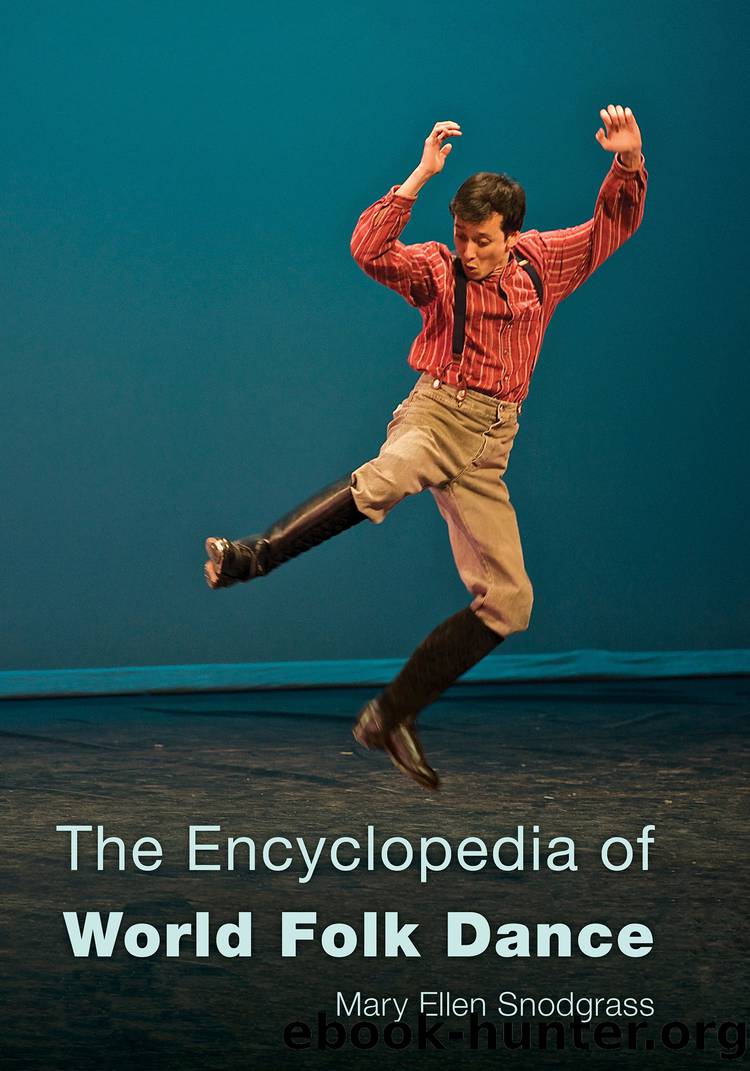The Encyclopedia of World Folk Dance by Snodgrass Mary Ellen;

Author:Snodgrass, Mary Ellen; [Snodgrass, Mary Ellen]
Language: eng
Format: epub
Publisher: Rowman & Littlefield Unlimited Model
Published: 2016-09-15T00:00:00+00:00
Lamentation Dance
Dances that lament unimaginable loss attest to the natural role of folk dance at pivotal moments in human fortune, as demonstrated by the dance dramas that mourners among the Gamberma of northern Togo and Benin perform for deceased elders, the Valencian vetlatori presented during mourning for a deceased infant, and the moirologia (mourning) that the encircling Byzantine laity presented in the church narthex at funerals. In Central Africa, the metempsychosis of the Angoni and Achewa dance aided the deceased to take the shape of a totemic animal. For the living, the Bechuana of South Africa arranged a monotone chant, crossed arms, and danced for orphans. The Bwiti of Gabon applied footwork to mourning, hexes, and healing. In West Africa, Yoruba mourners cared for a grieving family by sending a masked dancer to enact the meeting of the deceased with beloved ancestors.
Visceral acknowledgment of deep grief stands apart from a holiday spirit for its kinetic expression beyond the reach of keening and tears, as with the ring dance to repetitions of âdanâ in Oman and âowfâ in Syria, the Druze dirge performance in Lebanon, and the West Sumatran tari ilau of grieving females. Through circumambulation of a fire pit, cairn, or altar, the grieving reconnect with infinity and the certainty of death, a philosophy of Gilbert Islanders and New Guineans and of Greeks in Homerâs Iliad (800 BCE). In Mali, the Dogon orchestrate ceremonial masking of a secret brotherhood, which escorts the departed spirit into the afterlife with ritual and dance.
Prehistoric Mourning
In prehistoric Egypt, burial ritual swept the cemetery of evil spirits in the style of the god Bes, a protective deity over babies and women in childbirth. To honor a departed spirit, females processed at funerals and flourished palm branches before the tomb. While women clapped, men wearing tall caps woven of rushes stepped forward at a dignified pace. During the Middle Kingdom after 2000 BCE, dwarves performed gestures of grief in the funeral cortege, such as the dancers depicted on murals at the cemetery of Beni Hasan in Middle Egypt for princes Baqet III and his son Khety.
As a dance genre, lamentation has its roots in Egyptian liturgy and Hebrew scripture. It began after 1543 BCE with the mystic Egyptian dance of lamentation performed to Isis and Nephthys, complementary deities of the throne and housewifery. To plucks on the harp, the sister goddesses mourned the murder of their father/brother Osiris. For David, the founder of the Hebrew nation in the eighth century BCE, loss and death confirmed for Israelites the purpose of divine love. In Psalm 30, the shepherd poet rejoiced that a fearful and isolating turn of events revived choreography exalting a trust in Yahwehâs grace to all humankind.
In Judges 11, Jephthah, the eighth-century BCE judge and war general of Israelites who lived at Tob east of Gilead and southeast of the Sea of Galilee, rashly pledged to burn on the sacrificial altar the first person who emerged from his house when he returned from a military victory over Ammon, a kingdom east of the Jordan River.
Download
This site does not store any files on its server. We only index and link to content provided by other sites. Please contact the content providers to delete copyright contents if any and email us, we'll remove relevant links or contents immediately.
Call Me by Your Name by André Aciman(19895)
Ready Player One by Cline Ernest(13975)
How to Be a Bawse: A Guide to Conquering Life by Lilly Singh(7154)
Wiseguy by Nicholas Pileggi(5313)
The Kite Runner by Khaled Hosseini(4949)
On Writing A Memoir of the Craft by Stephen King(4658)
Audition by Ryu Murakami(4610)
The Crown by Robert Lacey(4568)
Call me by your name by Andre Aciman(4463)
Gerald's Game by Stephen King(4371)
Harry Potter and the Cursed Child: The Journey by Harry Potter Theatrical Productions(4313)
Dialogue by Robert McKee(4158)
The Perils of Being Moderately Famous by Soha Ali Khan(4064)
Dynamic Alignment Through Imagery by Eric Franklin(3914)
Apollo 8 by Jeffrey Kluger(3511)
How to be Champion: My Autobiography by Sarah Millican(3493)
The Inner Game of Tennis by W. Timothy Gallwey(3472)
Seriously... I'm Kidding by Ellen DeGeneres(3412)
Darker by E L James(3405)
